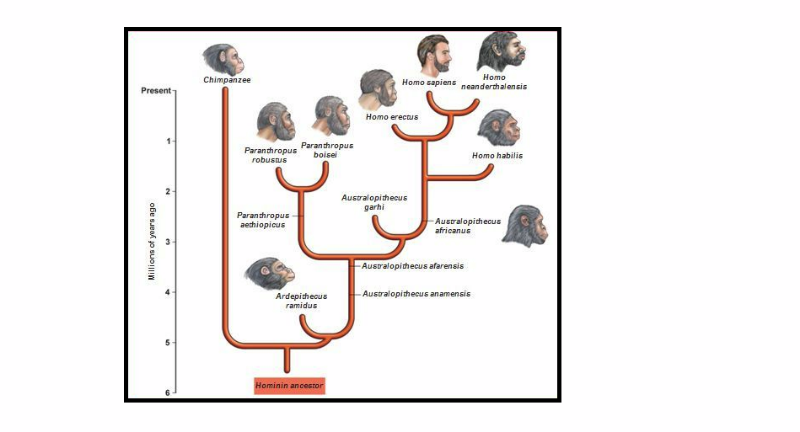Evolution
Table of Content |

What is Evolution?
Evolution is a process of change in the heritable characteristics of a population over successive generations. Evolution leads to diversity at species level as well as individual level.
Example of Evolution: Industrial melanism (change in the color of moths due to deposition of soot) observed in peppered moth, “Biston betularia”.
What do you mean by Evolutionary change?
 Evolutionary change is a slow change that occurs in a population of plants or animals during successive generations.
Evolutionary change is a slow change that occurs in a population of plants or animals during successive generations.
Evolution is a scientific fact whereas creationism is a pseudoscience, which fights with the religious policies.
What are different theories of Evolution?
There are different theories of Evolution that are known. The four basic theories of Evolution are explained below
1. Theory of Lamarckism
This theory is also known as “Theory of inheritance of acquired characters”. Lamarckism is based on the following postulates-
-
Living organism tends to increase in size.
-
New needs lead to the formation of new organs.
-
Continued use of a particular organ makes it more developed and disuse of an organ leads to its degeneration.
-
New characters are acquired by individuals during their lifetime
Evidence of theory of Lamarckism
-
Present day giraffe have long neck as compared to short neck giraffe that exists before. The gradual elongation of neck of giraffe occurs due to deficiency of food on the barren ground.
-
Present day limbless snakes are due to continued disuse of limbs by their ancestors. This is an example of continued disuse of organs which leads to their degeneration.
-
Flightless birds such as ostrich arise due to continued disuse of wings by their ancestors.
2. Theory of Darwin
Darwin theory was also known as “Theory of Natural selection”.
Postulates of Darwin theory
-
Speciation (formation of species) - Useful variations from generation to generation gives rise to the formation of new species.
-
Struggle of the existence Due to multiplication of organisms and limited food and space, there exists competition among the organisms. There are two types of competition
-
Intraspecific competition between the members of the same species for food and space.
-
Interspecific competition between members of different species for food and space.
-
Intraspecific competition is more intense than intraspecific competition.
-
Inheritance of useful variations According to Darwin, living organisms tend to adopt in the changing environment due to continuous variations.
-
Survival of the fittest or Natural selection Nature selects those characteristics or organisms that are useful and are best adapted to the prevailing conditions. For example: Industrial melanism observed in peppered moth in Britain.
Evidence of Darwin theory
-

Before industrial Revolution in Britain, the peppered moths appears pale in color and some are black which are easily eaten by birds. But after industrial Revolution, the bark of the trees becomes black due to soot deposition. Due to this, pale color moths are easily visible on black bark by birds and are easily eaten. This gives an advantage to black moths. This is known as adaptive radiation.
-
Antibiotic resistant bacteria- Bacteria and viruses reproduce at a very fast rate and evolve within a short time. This allows bacteria to evolve against a particular antibiotic and becomes resistant to it. Thus antibiotic resistant bacterial strain has advantage over non-resistant bacteria.
3. Mutation theory of Evolution
This theory was given by Hugo De Vries. He worked on evening primrose. Self-pollination of evening primrose was performed for several generations. And it was observed that most of the plants are similar to parental type and show very little variations. But with generations new varieties are produced very different from the parental type.
From the above observation, it was concluded that Evolution is a discontinuous process and occurs via mutation.
Evidence in favor of mutation theory
-
Appearance of short-legged sheep from long sheep parents after single generation supports mutation theory.
-
Inheritance of vestigial organs.
4. Modern concept of Evolution
This theory is also known as Synthetic Theory of Evolution.
Postulates of modern theory of Evolution
-
Genetic variability caused by mutations or chromosomal aberrations (deletion, duplication, inversion, and translocation) is essential for Evolution.
-
Reproductive isolation also drives Evolution.
-
Differential reproduction is another key for Evolution. Differential reproduction is defined as individuals who are better adapted to the environment will reproduce at a faster rate.
How a species can evolve?
The process of formation of distinct species by branching off from the ancestral population is known as speciation. There are different methods by which a species can evolve:
Fig. Types of speciation
1. Allopatric speciation
The genetic divergence brought about by geographic isolation is known as allopatric speciation.
For example: Divergence of Drosophila populations in the Hawaiian archipelago.
Divergence of two sub-populations due to reproductive isolation. Reproductive isolation can be due to competition for resources, disruptive selection and sexual selection.
For example: Divergence of Rhagoletis pomonella, maggot fly.
3. Parapatric speciation
A form of speciation in which the Evolution occurs when a species enters a new habitat or niche.
What is Evolution of man or Human Evolution?
Human Evolution is a very lengthy process and humans originated from ape-like ancestors. Ape-like ancestors evolved about 6 million years ago in Africa. Humans are primates. The modern man Homo sapiens are similar to another primate group, that is, apes. Modern man and apes have common ancestor. The scientific study of human evolution is known as Paleoanthropology.
Below figure depicts the timeline of Evolution of man:
Watch this Video for more reference

